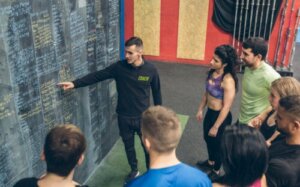The EMOM Routine in Crossfit: What Is It and How Can You Do It?


Reviewed and approved by the doctor Leonardo Biolatto
Within the world of CrossFit, there are many different training techniques. One of them is the EMOM routine, which consists of performing a set number of repetitions of an exercise in the span of 60 seconds. The remaining time is used for rest.
Its acronym stands for Every Minute On the Minute, so it suggests taking advantage of that short time with maximum intensity. For that purpose, powerful exercises and short burst breaks are applied.
The EMOM routine has other advantages, such as the versatility to be applied to almost any exercise or the possibility of easy tracking of individual progress. However, this is an advanced workout.
What are the features and benefits of the EMOM routine?
The main concept of EMOM is simple: set the round of repetitions to one-minute intervals, including rest. For example, if you set 15 reps of crunches and perform them in 40 seconds, the remaining 20 seconds are for rest. Then, when the next minute arrives, a new exercise begins.
This is a training protocol drawn from CrossFit. However, it’s possible to work it as a complete gym or outdoor routine, adjusting the intensity and applying progressions.
The only tool needed is a watch, stopwatch, or timer to measure the exact times. However, the EMOM routine is not recommended for people with little experience, heart disease, or diabetes, due to its demanding nature.
The benefits of this type of training
- Creativity: A great advantage is the possibility to adapt this type of training to almost any exercise. Squats, burpees, or pull-ups…the sky is the limit. The demand and the setup depend on the physical condition of each athlete.
- Time: This is an ideal routine for those who need to optimize their time. There are programs that last between 10 and 30 minutes.
- Tracking: With its 60-second structure, it becomes easy to measure individual progress. When the same number of repetitions is achieved in less time, for instance, it’s time to intensify.
- Toning: Body fat reduction is encouraged, in addition to improving speed, endurance, and oxygen consumption capacity.
- Group or solo: Combining an EMOM routine between two people is easy. Many trainers working with large groups use this technique to facilitate overall monitoring.

We think you may also enjoy reading this article: The Benefits and Risks of CrossFit: What You Need to Know
Recommended routines to get started
Before starting an EMOM routine, it’s important to perform warm-up exercises. You should do at least a few minutes of stretching or general movements, due to the physical demand that is going to be applied. This is a way to avoid overloading and injury.
For beginners
A simple way to start assimilating the 60-second lapses is to use exercises in which you have experience. For example, for the first minute, perform 10 push-ups. Rest until the time is complete and, in the second minute, move on to 10 squats. In the third, it can be 15 sit-ups. Finally, do 10 squat jumps.
Repeat for 3 rounds, which will result in a total 12-minute routine. Remember that rests only apply to the seconds left over. The faster you finish the repetitions, the more time you will have for rest.
Bodyweights
Calisthenics exercises are very adaptable to EMOM structures. For example, you can do 15 push-ups in the first 60 seconds, 20 squats in the second minute, and a 40-second plank to finish. These are only 3 exercises to be repeated 6 times.
Exercises for hypertrophy
A more intense plan, designed to build muscle, would consist of performing 8 repetitions of squats in the first minute, 8 pull-ups in the second minute, and taking the entire third minute to rest. Repeat 5 rounds for a total plan of 15 minutes. If desired, you can add one more exercise with 10 jumping burpees.
Burpees are a very popular practice within the EMOM routine. It’s even possible to do full rounds with this exercise alone.
Weightlifting
Whether in the gym or at home, the EMOM routine promotes focus and avoids distractions. One way to incorporate it into weightlifting is to perform a two-tempo exercise known as a clean and jerk.
Use the first minute for that and allow 60 seconds of rest in between. In the third half, add 3 front squats. The fourth minute is used to rest again and the fifth minute for another clean and jerk. Repeat all for 2 rounds.
Also for runners
If there are any athletes who specialize in controlling times, it is runners. For this reason, the EMOM protocol is very useful in running exercises. In this case, use a 5-minute plan for 4 rounds – i.e., a total run of 20 minutes.
Start with a sprint 400-meter run between minutes one and three. During the fourth and fifth, run another 300 meters. Rest in the remaining spaces.

What to consider when incorporating the EMOM routine into your training?
It’s possible to apply the EMOM structure to a wide variety of exercises. The important – and perhaps the most difficult – part is to coordinate the number of repetitions with their intensity.
The distribution of each minute depends on the type of exercise. But in general, the idea is to take 40 seconds to exercise and 20 seconds to rest.
It’s not advisable to take less than 15 seconds of rest. That said, it’s common that people sometimes start with a very ambitious plan without being prepared to face it.
To prevent the risk of muscular overload or injuries, it’s necessary to begin in a simple way and to incorporate weight or quantity of repetitions as the days advance. Another common mistake is to perform exercises too quickly in order to get more seconds of rest. In this way, correct postures are likely to be neglected.
It’s much more effective to apply fewer repetitions, but with more precise movements.
The seconds of rest should be used for relaxation, without performing another exercise. It’s important that the body recovers before a new movement or routine.
Like this article? You may also like to read: Maria Pedraza’s Workout Routine to Maintain a Slim Figure
Integrate your routines and be creative
Since this is a structuring protocol with intervals, it’s also possible to be creative when putting together your workout plans. For example, you can combine cardio exercises with weight lifting and even add dumbbells or stretching bands.
The more variety you create, the more you prevent boredom. On the other hand, make sure to always have a bottle of water nearby. These plans are often intense and demand constant hydration.
All cited sources were thoroughly reviewed by our team to ensure their quality, reliability, currency, and validity. The bibliography of this article was considered reliable and of academic or scientific accuracy.
- Dexheimer, Joshua D. et al. “Physiological Performance Measures as Indicators of Crossfit® Performance.” Sports 7.4 (2019): n. pag. Sports. Disponible en: https://doi.org/10.3390/sports7040093
- Ezequiel Kalin, Fernando, Nosotros hacemos CrossFit: etnografía sobre identidades deportivas. Educación Física y Ciencia [Internet]. 2017;19(2):1-14. Recuperado de: https://www.redalyc.org/articulo.oa?id=439954671002
- Elkin, Joshua L. et al. “Likelihood of Injury and Medical Care Between CrossFit and Traditional Weightlifting Participants.” Orthopaedic Journal of Sports Medicine 7.5 (2019): n. pag. Orthopaedic Journal of Sports Medicine. Web. Disponible en: https://doi.org/10.1177/2325967119843348
- Hall-López, Javier Arturo, Ochoa-Martínez, Paulina Yesica, Moncada-Jiménez, José, Ocampo Méndez, Mara Alessandra, Martínez García, Issael, Martínez García, Marco Antonio, Confiabilidad del consumo máximo de oxigeno evaluado en pruebas de esfuerzo consecutivas mediante calorimetría indirecta. Nutrición Hospitalaria [Internet]. 2015;31(4):1726-1732. Recuperado de: https://www.redalyc.org/articulo.oa?id=309238513037
- Urdampilleta, A., Martínez-Sanz, J.M., Julia-Sanchez, S., Álvarez-Herms, J., Protocolo de hidratación antes, durante y después de la actividad físico-deportiva. Motricidad. European Journal of Human Movement [Internet]. 2013;31( ):57-76. Recuperado de: https://www.redalyc.org/articulo.oa?id=274229586004
This text is provided for informational purposes only and does not replace consultation with a professional. If in doubt, consult your specialist.








